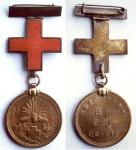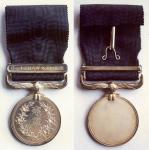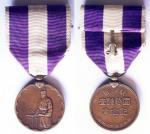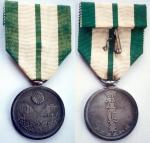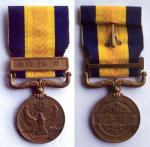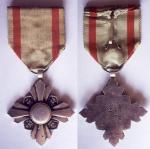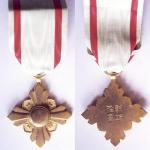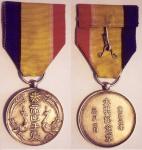-
Posts
2,123 -
Joined
-
Last visited
-
Days Won
4
Content Type
Profiles
Forums
Blogs
Gallery
Events
Store
Everything posted by Paul L Murphy
-
-
-
Next up, two different versions of the Red Cross medal for the 1904-05 Russo Japanese War. The Geneva Cross version is very scarce, the other suspender (which reads Commemorative) is scarce.
-
This is the most common version of the Merit Medal. It is the version with a dark blue ribbon and is asingle bar award, ie. a first award.
-
This is the Korean First National Census Commemorative Medal. Only the reverse inscription differentiates it from the more common Japanese version. This version is quite scarce.
-
Moving across to the Japanese puppet state of Inner Mongolia. This is their National Foundation Commemorative Medal. A nice scarce and little known award.
-
This unofficial medal was issued to his troops by General Homma for the capture of the Philippines. Officers received it in silver and everyone else received the bronze version shown here. Very few of these troops made it back alive to Japan so the survival rate of these unofficial medals is low.
-
Next up a rare medal that most collectors have never seen. This is the China Incident Commemorative Medal. It is the medal which was given to Chinese collaborators and others who were not eligible to receive the China Incident War Medal. Given that the war Medal was dished out to everyone, recipients of this one were few and far between, and unlikely to hold onto it after the Japanese defeat !
-
Moving back to Japan proper, this is the Capital Rehabilitation Medal which was awarded to those who took part in the reconstruction of Tokyo after the Great Kanto Earthquake.
-
-
Next up, and still in Manchuria, we have the Border Incident Commemorative Medal. This was awarded for the fighting on the Chinese Mongolian border in 1938.
-
Going one lower, we have the 8th Class of the Auspicious Clouds. Same design as previous only this time in silver, rather than with a gilt finish. This is a nice salty one that I picked up in a Kyoto flea market.
-
-
One of the medal groups in my collection is an interesting group to the 2nd Battalion Royal Scots. It is a WWI War Medal, Victory Medal, GV Army LS&GC Medal and a GV Meritorious Service Medal all on nicely worn ribbons (unmounted) named to 5918 WO CL 2 G.F. Archibald 2/Royal Scots. They came together with a 1939-45 Star, Pacific Star and WWII War Medal on new ribbons and when I bought them (a good few years ago) the seller advised that he believed Archibald had served with the Royal Scots in Hong Kong and was entitled to the three WWII medals as a result. Is anyone able to confirm or deny this particular rumour since there is no paperwork with them to verify the entitlement ??
-
Ed, I'm not sure. Poo can be pretty bad, especially when it comes shooting out of the end of a 13 month old baby !
-
To illustrate what I mean, here is the genuine Manchurian Enthronement Commemorative Medal whose obverse has been stolen for this monstrosity.
-
Paddywhack, afraid to say it is a piece of poo. It is about as appealing as the very toxic nappy my 13 month old daughter created for me when I was on babysitting duty this evening. There is a huge variety of this stuff coming out of China. Genuine Imperial Chinese / Manchurian / Korean medals were well made and die struck from good quality metals. This crap is cast or poorly struck from cheap bronze. Also the obverses and reverses are often unrelated to each other but unless you can read Chinese that is not much help. In general, stay a mile away from anything that looks like this.
-
Hi paddywhack, no problem at all.
-
This is a fake. There is a huge range of this crap coming out of China for the past couple of years. You can buy them in Shanghai for US$1 per piece. Paddywhack has posted a similar medal in another forum and asked the same questions, where it was also identified as a fake, so I presume this was to get a second opinion ? The second opinion, well it is still fake.
-
Go on show the certificates, you know you want to It should be a Golden Kite 7th Class and either a Rising Sun or Sacred Treasure 8th Class to a Senior Infantry Private for the Russo Japanese War. I love these sets when the soldiers went to the expense of buying these large storage boxes (they are private purchase items not government issue as some e-bay sellers try to claim). It shows that the original owner was proud of what he obtained and makes it that little bit more important to keep everything together in good condition. Unfortunately in Japan you normally find these boxes split away from the certificates which is why I try to buy such compelte sets any time I find them. Having said all that ....... show us the certs
-
My money is on sake cups......really really nice sake cups ...... Bye the way, you have some nice boxes around it, is the Russo Japanese War box to the left full or empty ?
-
Hi Christian, The only information I have about the Concert Front is that basically it was organised by the Ministry of Culture to ensure that the officers and troops were properly entertained. The Bolshoi Theatre was responsible for organising it and the various theatres and conservatoires had to contribute. Unfortunately I do not have any details of the awards given to members but Zvyagina received the Red Star and the Medal for Military Service. Best regards, Paul






